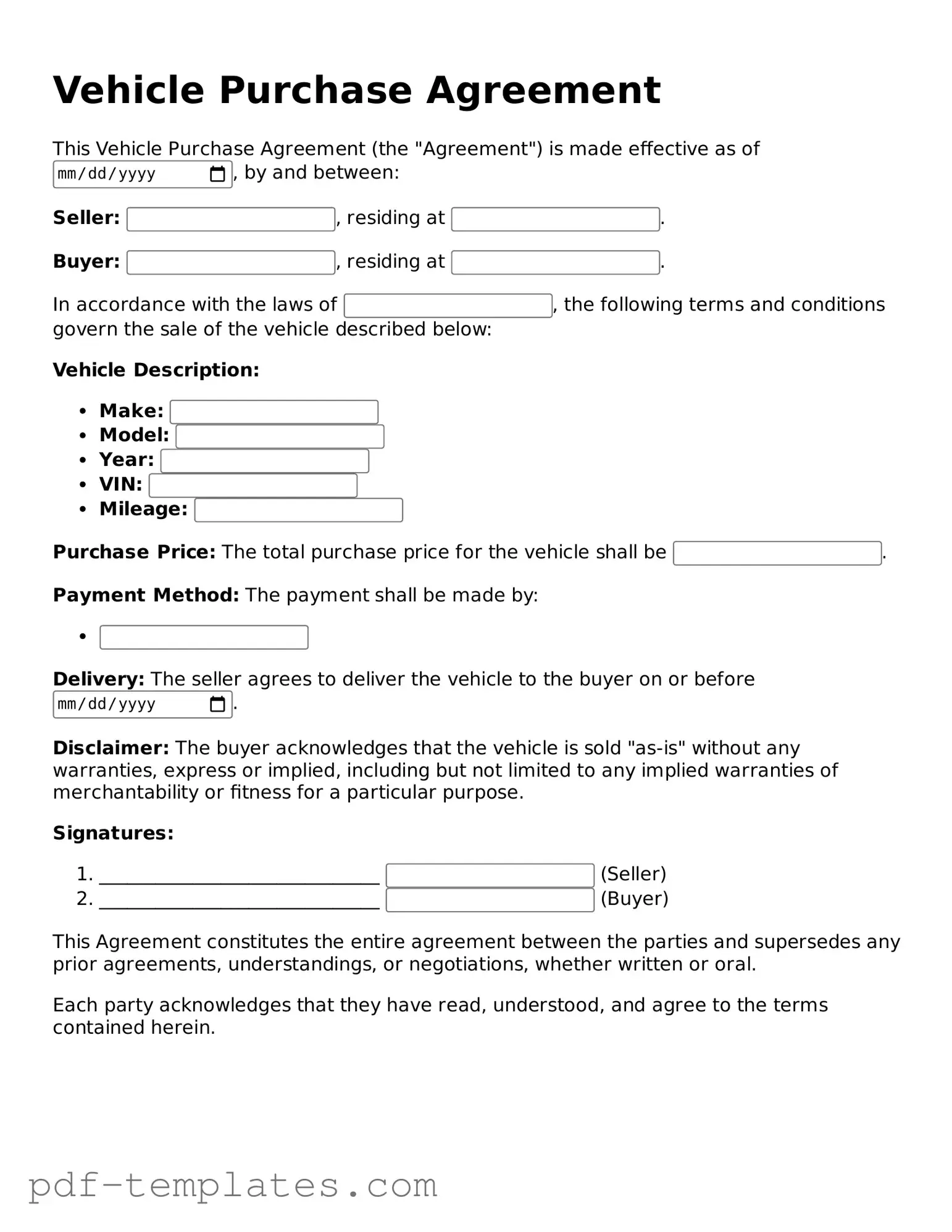The Vehicle Purchase Agreement is quite similar to a Bill of Sale. Both documents serve as proof of the transaction between the buyer and seller. A Bill of Sale typically includes details such as the names of the parties involved, the description of the vehicle, the sale price, and the date of the transaction. This document is often used to finalize the sale and can be required for registration purposes, just like the Vehicle Purchase Agreement.
Another document that shares similarities is the Lease Agreement. While a Vehicle Purchase Agreement is focused on the sale of a vehicle, a Lease Agreement outlines the terms under which a vehicle can be rented for a specific period. Both documents detail the parties involved, the vehicle's description, and the financial terms. However, the Lease Agreement emphasizes the responsibilities of the lessee and lessor during the lease term.
A Purchase Order is also comparable to the Vehicle Purchase Agreement. It is a document that confirms the buyer's intent to purchase goods or services, including vehicles. Like the Vehicle Purchase Agreement, it specifies the terms of the transaction, such as price and delivery details. However, a Purchase Order is typically used in a business context and may not include the same level of detail about the condition of the vehicle.
The Sales Contract is another document that closely resembles the Vehicle Purchase Agreement. This contract outlines the terms of sale between the buyer and seller for various goods, including vehicles. It includes essential information such as the purchase price, payment terms, and delivery conditions. Both documents aim to protect the interests of both parties involved in the transaction.
A Service Agreement can also be seen as similar, especially when considering the maintenance and servicing of a vehicle. While it does not pertain directly to the sale, it often accompanies the purchase of a vehicle. This document outlines the terms under which a service provider will maintain or repair the vehicle, ensuring that the buyer understands their ongoing responsibilities.
If you are entering into a horse sale, be sure to take advantage of the informative resources available, including the comprehensive Horse Bill of Sale information to guide you through the process.
The Financing Agreement is another related document. When purchasing a vehicle, many buyers opt for financing, which requires a separate agreement detailing the loan terms. This document specifies the loan amount, interest rate, repayment schedule, and any collateral involved. Like the Vehicle Purchase Agreement, it serves to formalize a financial commitment between the buyer and the lender.
The Title Transfer Document is crucial in the vehicle purchase process. This document officially transfers ownership of the vehicle from the seller to the buyer. It includes information about the vehicle, such as the VIN and the names of both parties. Like the Vehicle Purchase Agreement, it must be completed and signed to ensure a smooth transition of ownership.
A Warranty Agreement also shares similarities with the Vehicle Purchase Agreement. When purchasing a vehicle, buyers often receive warranties that guarantee certain repairs or services for a specified period. This document outlines the terms and conditions of the warranty, including what is covered and the duration. Both agreements aim to protect the buyer's investment.
Lastly, the Trade-In Agreement can be considered similar, especially when a buyer is trading in their old vehicle as part of the purchase. This document outlines the terms of the trade-in, including the vehicle's value and how it will be applied to the purchase price of the new vehicle. Like the Vehicle Purchase Agreement, it is essential for documenting the transaction and ensuring both parties are clear on the terms.
